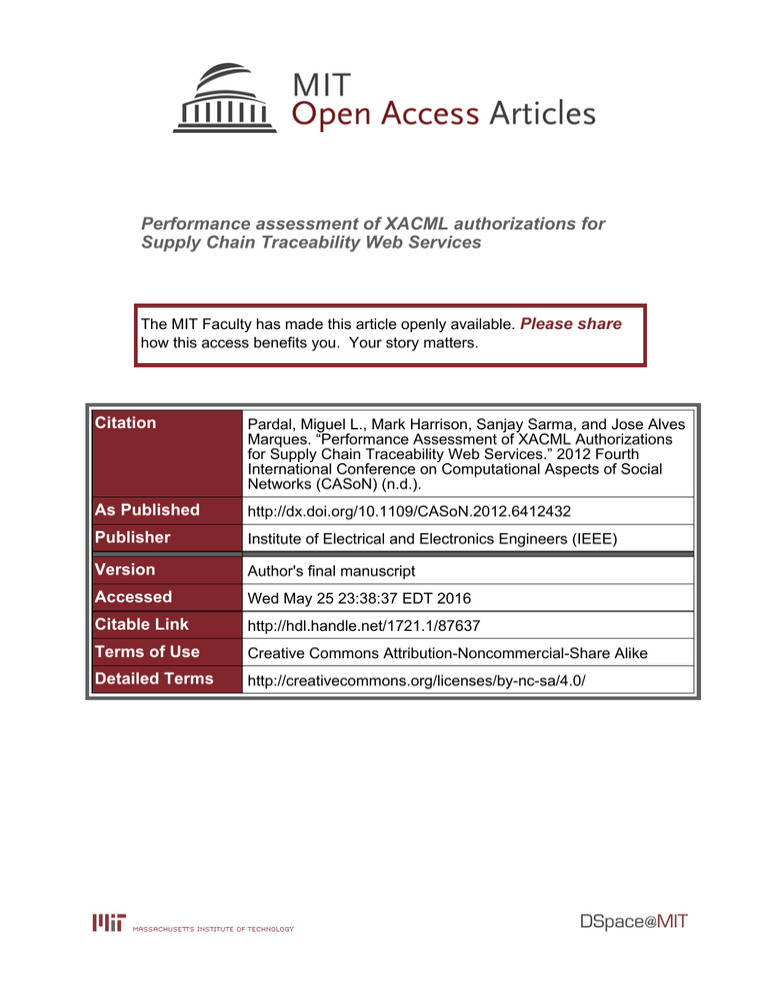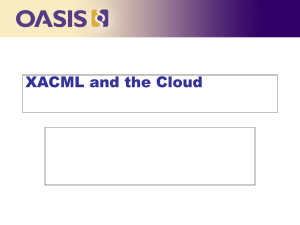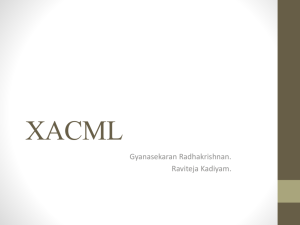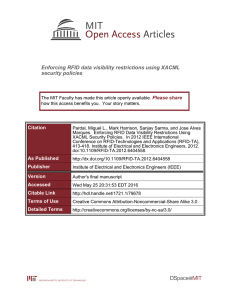Performance assessment of XACML authorizations for Supply Chain Traceability Web Services
advertisement

Performance assessment of XACML authorizations for Supply Chain Traceability Web Services The MIT Faculty has made this article openly available. Please share how this access benefits you. Your story matters. Citation Pardal, Miguel L., Mark Harrison, Sanjay Sarma, and Jose Alves Marques. “Performance Assessment of XACML Authorizations for Supply Chain Traceability Web Services.” 2012 Fourth International Conference on Computational Aspects of Social Networks (CASoN) (n.d.). As Published http://dx.doi.org/10.1109/CASoN.2012.6412432 Publisher Institute of Electrical and Electronics Engineers (IEEE) Version Author's final manuscript Accessed Wed May 25 23:38:37 EDT 2016 Citable Link http://hdl.handle.net/1721.1/87637 Terms of Use Creative Commons Attribution-Noncommercial-Share Alike Detailed Terms http://creativecommons.org/licenses/by-nc-sa/4.0/ Performance Assessment of XACML Authorizations for Supply Chain Traceability Web Services Miguel L. Pardal† , Mark Harrison‡ , Sanjay Sarma§ , José Alves Marques† † Department of Computer Science and Engineering Instituto Superior Técnico, Technical University of Lisbon, Portugal ‡ Auto-ID Labs, Institute for Manufacturing, University of Cambridge, UK § Auto-ID Labs, Massachusetts Institute of Technology, USA Email: miguel.pardal@ist.utl.pt, mark.harrison@cantab.net, sesarma@mit.edu, jose.marques@link.pt Abstract—Service-Oriented Architecture (SOA) and Web Services (WS) offer advanced flexibility and interoperability capabilities. However they imply significant performance overheads that need to be carefully considered. Supply Chain Management (SCM) and Traceability systems are an interesting domain for the use of WS technologies that are usually deemed to be too complex and unnecessary in practical applications, especially regarding security. This paper presents an externalized security architecture that uses the eXtensible Access Control Markup Language (XACML) authorization standard to enforce visibility restrictions on traceability data in a supply chain where multiple companies collaborate; the performance overheads are assessed by comparing ‘raw’ authorization implementations - Access Control Lists, Tokens, and RDF Assertions - with their XACML-equivalents. If WS-Security [4] technologies are used, then the overheads are even more significant: messages are 27 times larger, and response times are 15 times slower. The main reason for these overheads was found to be the use of verbose XML data encoding for the message formats. The data access mode is also relevant. Bayardo et. al [5] found in their study that stream-based data access gives significantly better performance than document-based access. In this paper, we investigate the performance of using WS authorizations in the supply chain traceability domain. Dynamic authorization is necessary because there are multiple companies involved, they are distributed across the world, and many of them do not have prior knowledge of the others. Keywords-Web Services; Authorization; XACML; Performance; Supply Chain Traceability A. Supply Chain Traceability I. I NTRODUCTION Service-Oriented Architecture (SOA) [1] and Web Services (WS) [2] were envisioned to cope with constant software change and to simplify the interoperation of heterogeneous systems. WS-related standards1 address non-functional concerns such as security, transactions, and reliable messaging. However, the complexity of these standards, alone and combined, raises significant performance concerns. The main criticism against the use of WS technologies is that they are slow and difficult to use. The performance overheads have been measured in practical implementations. Juric at al. [3] compared the performance of SOAP with platform-specific technologies, namely, with Java Remote Method Invocation (RMI). They reported that a typical SOAP message is, on average, 4.3 times larger than an RMI message, and that the WS response time is 9 times slower than RMI. 1 WS is used here as an ‘umbrella’ term that refers to most variants of eXtensible Markup Language (XML) message formats and protocols built to provide data services, including SOAP messages containing headers (metadata) and body (payload), and also Representational State Transfer (REST) that provides granular access to resources. The world economy depends on countless supply chains that provide goods from producer to consumer. Supply Chain Management (SCM) solutions focus on planning and execution, integrated with companies’ Enterprise Resources Planning (ERP) systems. Their purpose is to optimize the physical object flows so that goods travel in the least amount of time and at the lowest cost [6]. To achieve this goal, it is necessary to keep track of what is moving along the supply chain. Radio Frequency Identification (RFID) technology [7] can significantly improve supply chain traceability, by allowing automatic data capture by RFID readers of identifiers stored inside RFID tags attached to items and/or pallets. Captured data is stored by each company at dispersed data silos. The Electronic Product Code (EPC) Network architecture [8] defines standard data capture and query interface for repositories of RFID data, called the EPC Information Services (EPC IS) [9]. EPC Discovery Services (EPC DS) [10] [11] can index these scattered repositories and allow traceability queries [12], such as Track (Where is the item?) and Trace (Where has the item been?) to be efficiently answered. Each supply chain participant can benefit from exchanging data with other companies, but information such as the levels of demand, inventory, and supplier identities should be kept private in a restricted circle of trust. Data access control is crucial if companies will be willing to share data [13]. Authentication B. Overview II. T RACEABILITY S YSTEM There are several architecture proposals to build traceability systems. Pardal and Alves Marques [14] summarized them using the criteria of centralization and data integration. For this work the Meta-Data Integration (MDI) architecture was chosen as the reference because it is aligned with the EPC Network architecture [8], defining two system layers: • EPC IS servers collect the detailed event data; • EPC DS servers store data links to EPC IS servers. Using this approach, traceability data sharing policies can be authored by the data owner and then used both at EPC DS and IS layers, as depicted in Figure 1. Traceability Broker EPC DS Access policy Access policy Factory Fig. 1. Data Availability Integrity Confidentiality Subject This paper compares the performance of visibility restriction approaches for supply chains using an authorization component of an externalized security architecture that relies on SOA principles and WS-related technologies; ‘raw’ implementations are compared with equivalent policies in a standard authorization language to measure the overheads. In the next section, the traceability system architecture for the supply chain domain is described. Then the externalized security architecture is presented with specific focus on authorization. Next we describe the supply chain authorization implementations along with their conversion to a standard authorization language. The paper ends with the performance assessment, conclusions and future work prospects. EPC IS Authorization Non repudiation Environment User management Auditing Fig. 2. Security properties. access must be authorized. The authentication can be achieved with identity providers [16] and the exchange of SAML assertions [17]. The authorization can be achieved with XACML [18] that is an XML vocabulary to represent authorization policies and requests that avoids hard-coded rules and allows improved consistency of policy enforcement. Hebig et al. [19] demonstrated how the different technologies needed for externalized security can work together. A. eXtensible Access Control Markup Language XACML [18] allows fine-grained access control and combination of (possibly conflicting) policies in an externalized security architecture. In general terms, an authorization is the verification of a subject’s right to execute an action on a resource. The standard defines a policy format, follows a processing model and requires actual implementation. 1) Policy: Figure 3 presents a simplified XACML Policy structure with target and rules. Policy * Ref. EPC IS Access policy 1 Distributor Data Retailer EPC IS Access policy Resource Action rule combining algorithm * * Subject * Action Target * Resource * Environment Rule 1 Effect 1 Target ... Data 0..1 XACML authorization policies protect both EPC DS and IS. III. E XTERNALIZED S ECURITY The goal of the externalized security architecture is to unify the security management across applications so that business rules can be changed dynamically. For this reason, it is especially suited to virtualized cloud deployments [15]. Externalized security encompasses user management, authentication, authorization, logging and auditing. The security properties to be preserved from attacks are depicted in Figure 2. Companies have to be authenticated and data Fig. 3. Condition XACML simplified Policy model. The target defines a simplified set of conditions that determine if the policy is relevant for the request. Rules are conditions that evaluate to ‘Permit’, ‘Deny’, ‘NotApplicable’ (when no target matches), or ‘Indeterminate’ (when internal errors occur). XACML has a set of predefined functions that are used to transform and compare data attributes, to arrive at an outcome. Policies are declarative and do not allow function definitions to keep algorithmic complexity low [20]. Additional functions can be provided by the library implementations, but this limits the compatibility of policy interpretation. 2) Execution: The authorization architecture that XACML assumes is defined by RFC 2753 [21] and 2904 [22], and defines several structural elements represented in Figure 4. The Policy Administration Point (PAP) is used to author and manage policies. The Policy Enforcement Point (PEP) is an application-specific component that intercepts requests to access a resource, and can also perform ‘before’ or ‘after’ actions, called obligations. The PEP checks with the Policy Decision Point (PDP), a generic component that takes any request along with a set of policies, and evaluates the request with respect to the applicable policies. The Policy Information Point (PIP) retrieves additional attribute values for the PDP not contained in the request, if required. 1: access attempt 6: permit / deny PEP PIP 5: obligations Obligation service 2: request 3: attribute values 4: response PAP PDP 0: policies Fig. 4. XACML request processing. 3) Implementations: There are several available XACML libraries and tools, both open-source and commercial. The open-source implementations were surveyed and the findings are presented in Table I. Impl. sunxacml Version 1.2 Last update Jul 2004 Heras-AF 1.0.0-M2 Sep 2010 enterprise -java-xacml PicketBox xEngine r258 Jan 2009 3.0.0.Final beta 0.2 Feb 2011 Aug 2010 Sponsors Sun Microsystems (currently Oracle) U. Applied Sciences Rapperswil, Switzerland Zian Wang tion. The open-source version has only an in-memory policy repository and the project has been inactive since 2010. ‘enterprise-java-xacml’ has the best reported performance [24] but has little documentation. PicketBox is supported by JBoss and the code appears to be converging to production-quality but the library is insufficiently documented at the present time. XEngine [25] also claims to have the best performance but it is insufficiently documented and is currently inactive. HERAS-AF was picked for this research because of the breadth of available documentation, including open access to the source code. IV. S UPPLY C HAIN AUTHORIZATIONS Access control for supply chains is different from traditional authorization because there is a lack of prior knowledge about who should be authorized due to the way that each physical object path emerges [26]. The Supply Chain Authorization (SC-Az) Application Programming Interface (API) has been proposed recently [27] to allow companies participating in a supply chain to express their authorizations using business concepts such as item, company, etc.; and then to enforce the resulting policies using alternative underlying mechanisms. The previous SC-Az version had two implementations: Enumerated Access Control (EAC) and Chain-of-Communication Tokens (CCT). EAC uses an Access Control List (ACL) implementation available on the Java virtual machine3 . CCT represents access rights within object references, called tokens, implemented with custom code. For this research, we added a new implementation, Chain-of-Trust Assertions (CTA), based on the Apache Jena4 Semantic Web [28] library. A. Chain-of-Trust Assertions CTA is different from EAC and CCT because its semantics can be extended. Access rights are expressed using logical statements, called assertions, issued by the multiple parties. Figure 5 shows the assertion-related operations. <<interface>> CTA +requestAssertion(user, action, resource) : Assertion +addAssertion(assertion) +checkAssertions(user, action, resource): Decision JBoss, Red Hat Michigan State U., North Carolina State U. TABLE I O PEN - SOURCE XACML IMPLEMENTATIONS . Sun XACML library is the reference implementation, sponsored by Sun Microsystems, but has not been updated since 2004. Since the project has been made publicly available, several “branches” were created by different sponsors. There is a 2.0 version under development but its sponsorship is not clear and it breaks source code compatibility. HERAS-AF2 [23] is a well documented library. It was developed in academia, but is currently also used in produc- Fig. 5. Access is granted if there is an explicit unbroken chain of trust assertions leading back to the owner of the data. Figures 6 and 7 show a simple CTA policy stated in Resource Description Framework (RDF) classes and properties, expressed as subject-predicate-object tuples. In the example, policy0 created by company0 (data owner) grants read access to record0 about item0 to company0 and company1. The extensibility can be achieved by adding new properties e.g. cta:grantsWrite to grant write access. 3 Package 2 Holistic Enterprise-Ready Application Security Architecture Framework. CTA interface operations. sun.security.acl 4 http://jena.apache.org/ :company0 :company1 a a cta:Organization . cta:Organization . :item0 :record0 :policy0 a a a cta:Identifier . cta:Record . cta:Policy . :company0 :record0 cta:publishes cta:about :record0 . :item0 . :company0 :policy0 :policy0 :policy0 cta:creates cta:protects cta:grantsRead cta:grantsRead :policy0 . :item0 . :company0 . :company1 . Fig. 6. CTA Policy in RDF Turtle format. D. Related work WS technologies are already widely used in RFID system implementations. The most prominent example is Fosstrak [30] that provides a SOAP endpoint to the EPC IS event repository. Also, Guinard [15] developed alternative RESTbased interfaces and explored cloud-based deployment. Shi et al. [31] implemented a secure DS and used an extended attribute-based access control to implement finegrained access policies in detail. Their custom policy engine is specialized but does not realize the benefits of using a standard policy language, making auditing and policy validation harder. In any case, their engine can be extended to recognize XACML as an input format. Kerschbaum and Chaves [32] propose an encryption scheme that allows different levels of fine-grained access control to be enforced on each item, also relying on the central role played by a DS. V. P ERFORMANCE ASSESSMENT Fig. 7. CTA Policy graph. B. Conversion to XACML To convert a CTA policy to a XACML policy the RDF statements are navigated in the following fashion: first the objects of “pol protects id” statements are found. For each item identifier, a XACML policy is created. The policy target matches the item identifier. A permit rule is created to grant each access right – e.g. read – to the objects from “pol grantsRead org” statements. A final catch rule is created so that all other requests regarding the item are also denied. The rule combining algorithm is ‘first-applicable’ so the outcome of the matched first rule is the access decision. This conversion approach is based on the policy conversions by Karjoth et al. [29], and it allows SC-Az policy instances to be represented in the standard XACML format5 . C. Deployment For the authorizations in the traceability system, XACML is used as the canonical format for representing data access policies, both at the EPC IS and DS levels, as depicted in Figure 1. The policy master copy is maintained at the EPC DS, but a local copy is maintained in each IS to also protect its records locally. 5 The conversion of EAC and CCT to XACML is described in [27]. The aim of the performance assessment was to evaluate if the performance of the solution is suitable for potentially very large and complex supply chains. The SC-Az assessment tool [27] was used to perform test runs to measure both from the ‘raw’ EAC, CCT and CTA mechanisms and from their XACML-equivalent forms. The test machine was a Quad-core CPU6 at 2.50 GHz, with 3.25 GB of usable RAM, and 1 TiB hard disk; running 32-bit Windows 7 (version 6.1.7601), and Java 1.7.0 04. The policies were defined using the common SC-Az API to allow the same business needs to be represented internally by each implementation. The policies were then converted to XACML format and tested using the HERAS-AF implementation to assess the correctness and the performance. A. Evaluation The data sharing policies were correctly translated and enforced. The performance results are the average of repeated runs of the same experiments, to achieve statistical confidence in the data. The number of items considered in the experiments were based on information collected by Ilic et al. [33]. We start with small number of items (100) and go up to medium number (104 ). 1) Raw: Figure 8 presents a plot of the ‘request evaluation’ time for increasing number of policies protecting items. We can see that the performance of CCT implemented with custom code is clearly the worse. EAC using Java’s ACLs and CTA using Apache Jena’s RDF handle the loads much better with results below 0.1 ms. The reason for this difference could be that the CCT implementation is stateful whereas EAC and CTA are stateless. CCT needs to perform (unoptimized) searches in token collections to find the right token for each request while the other two receive all the values as arguments. 6 Intel Core 2 Quad Central Processing Unit Q8300 Time (ms) 1 VI. C ONCLUSION EAC CCT CTA 0.8 0.6 0.4 0.2 0 Fig. 8. 0.2 0.4 0.6 Policies 0.8 1 ·104 Raw evaluation time with increasing number of policies. 2) XACML: Figure 9 presents a plot of the ‘request evaluation’ time, again for increasing number of policies converted to XACML format. Time (ms) EACx CCTx CTAx 10 5 0 Fig. 9. 0 0.2 0.4 0.6 Policies 0.8 1 ·104 XACML evaluation time with increasing number of policies. The performance of CCT and CTA are the best, EAC is worse, but on the same order of magnitude. 3) Raw vs. XACML: Comparing the y-axis of Figures 8 and 9 it is visible that the XACML performance overheads are very significant. Table II presents each XACML time divided by the corresponding ‘raw’ time for chains handling increasing numbers of items protected by policies. We observed a 400fold overhead, on average. Also, the performance overhead increases with the number of deployed policies. Nr. Policies 0.01 · 104 0.05 · 104 0.1 · 104 0.5 · 104 1 · 104 EAC 49.9 240.0 406.7 1670.1 3684.4 CCT 58.9 63.9 57.5 17.3 10.1 CTA 22.7 103.5 191.4 752.9 1429.2 TABLE II XACML OVERHEAD WITH INCREASING NUMBER OF ITEM POLICIES . The first contribution of this paper is the performance assessment of the enforcement of supply chain data visibility policies, in the context of an externalized security architecture. First, we verified that the policies could be translated and enforced using a standard XACML infrastructure. Then we compared the performance of the ‘raw’ implementations with the XACML-converted policies for increasing number of items being protected. The XACML overheads were found to be very significant: 400 times on average, and over 1000 times in the worst cases. Our results agree with previous research [3] [5] that shows that WS technologies overheads are usually very significant. There is a clear need to simplify and streamline the standards and there is room for performance improvements in the implementations. However, despite these drawbacks, WS technologies are being widely used today, meaning that their advantages – interoperability, flexibility, tooling support – add value for developers and make up for the additional cost. That is also the case for using XACML to protect supply chain data. XACML allows the policies to be exchanged in a standard format that can be properly interpreted in all the policy enforcement points and allows the use of other tools that comply with the standard (e.g. auditing tools). The second contribution of this work is the extension of the Supply Chain Authorization (SC-Az) API with the Chainof-Trust Assertions (CTA) implementation based on Semantic Web technologies. CTA has extensible semantics while EAC and CCT have predefined semantics and, because of this, CTA was expected to be slower. However, for the SC-Az baseline when all three mechanisms express exactly the same visibility restrictions there are no significant performance differences for evaluation of requests, and CTA is even better than EAC. Considering that the performance is similar and that CTA is extensible, moving forward CTA should be the default choice for expressing supply chain authorizations. A. Future work There are indications that the performance overheads reported using the HERAS-AF library could be significantly lowered with more optimized alternatives [34] [25]. This proposition needs to be measured in practice before more general conclusions can be drawn. The evaluation job execution will be enhanced to measure the performance of XACML with a large number of items (more than 104 items [33]). The performance impact of representing object groupings – batches – and company sets – groups – will also be assessed. The suitable performance of CTA opens possibilities for more expressive traceability data sharing policies. Trust can be transitive in some cases, as tested already with good preliminary results. Also, instead of issuing plain trust assertions, parties can issue conditional assertions, like reciprocal trust (“I trust you if you trust me”). Additionally, special predicates can be designed to express dynamic chain upstream/downstream conditions, allowing data sharing (or at least, initial data discovery) between parties that did not have previous interactions. It can also support the delegation of administrative rights from one organization to another. All of these can be particularly useful in scenarios like recalls [35]. The authorization challenges of externalized security in the supply chain traceability system illustrated how WS can assist in complex and dynamic business environments involving multiple organizations. Many more WS research can be done in this domain as traceability systems requirements are a worthy match for Web Services’ advanced capabilities. ACKNOWLEDGMENT Miguel L. Pardal is supported by a PhD fellowship from the Portuguese Foundation for Science and Technology FCT (SFRH/BD/45289/2008). R EFERENCES [1] T. Erl, SOA Principles of Service Design. Prentice Hall, July 2007. [2] G. Alonso, F. Casati, H. Kuno, and V. Machiraju, Web Services: Concepts, Architectures and Applications. Springer Verlag, 2004. [3] M. B. Juric, I. Rozman, B. Brumen, M. Colnaric, and M. Hericko, “Comparison of performance of Web Services, WS-Security, RMI, and RMI-SSL,” Journal of Systems and Software, vol. 79, no. 5, pp. 689– 700, 2006. [4] K. Lawrence, C. Kaler, A. Nadalin, R. Monzillo, and P. HallamBaker, Web Services Security: SOAP Message Security 1.1, OASIS Std., February 2006. [5] R. J. Bayardo, D. Gruhl, V. Josifovski, and J. Myllymaki, “An evaluation of binary XML encoding optimizations for fast stream based XML processing,” in Proc. of the 13th Int’l Conf. on World Wide Web, ser. WWW. New York, NY, USA: ACM, 2004, pp. 345–354. [6] K. Laudon and J. Laudon, Management Information Systems - 12th edition. Prentice Hall, January 2011. [7] E. W. Schuster, S. J. Allen, and D. L. Brock, Global RFID: The value of the EPCglobal network for supply chain management. Springer, 2007. [8] F. Thiesse, C. Floerkemeier, M. Harrison, F. Michahelles, and C. Roduner, “Technology, Standards, and Real-World Deployments of the EPC Network,” IEEE Internet Computing, vol. 13, no. 2, pp. 36–43, 2009. [9] EPCglobal, EPC Information Services (EPCIS) 1.0.1 Specification, GS1 Std., September 2007. [10] J. J. Cantero, M. A. Guijarro, A. Plaza, G. Arrebola, and J. Baos, “A Design for Secure Discovery Services in the EPCglobal Architecture,” in Unique Radio Innovation for the 21st Century, D. C. C. Ranasinghe, Q. Z. Z. Sheng, and S. Zeadally, Eds. Springer Berlin Heidelberg, 2010, pp. 183–201. [11] C. Kürschner, C. Condea, O. Kasten, and F. Thiesse, “Discovery Service Design in the EPCglobal Network, Towards Full Supply Chain Visibility,” Internet of Things, pp. 19–34, 2008. [12] R. Agrawal, A. Cheung, K. Kailing, and S. Schonauer, “Towards Traceability across Sovereign, Distributed RFID Databases,” in Int’l Database Engineering and Applications Symp. (IDEAS), 2006. [13] M. Eurich, N. Oertel, and R. Boutellier, “The impact of perceived privacy risks on organizations’ willingness to share item-level event data across the supply chain,” Journal of Electronic Commerce Research, vol. 10, no. 3-4, pp. 423–440, December 2010. [14] M. L. Pardal and J. A. Marques, “Cost Model for RFID-based Traceability Information Systems,” in IEEE Int’l Conf. on RFID Technology and Applications, September 2011. [15] D. Guinard, C. Floerkemeier, and S. Sarma, “Cloud computing, REST and Mashups to simplify RFID application development and deployment,” in Proc. of the 2nd Int’l Workshop on Web of Things (WoT). ACM, 2011, pp. 9:1–9:6. [16] D. Baier, V. Bertocci, K. Brown, E. Pace, and M. Woloski, A Guide to Claims-Based Identity and Access Control. Microsoft, 2010. [17] S. Cantor, J. Kemp, R. Philpott, and E. Maler, Assertions and Protocols for the OASIS Security Assertion Markup Language (SAML) V2.0, OASIS Std., March 2005. [18] B. Parducci, H. Lockhart, and E. Rissanen, eXtensible Access Control Markup Language (XACML) Version 3.0, OASIS Std., August 2011. [19] R. N. Hebig, C. Meinel, M. Menzel, I. Thomas, and R. Warschofsky, “A Web Service Architecture for Decentralised Identity- and AttributeBased Access Control,” in Proc. IEEE Int’l Conf. Web Services (ICWS), 2009, pp. 551–558. [20] C. Alm and R. Illig, “Translating High-Level Authorization Constraints to XACML,” in Proc. 6th World Congress Services (SERVICES-1), 2010, pp. 629–636. [21] R. Yavatkar, D. Pendarakis, and R. Guerin, RFC 2753 – A Framework for Policy-based Admission Control, IEFT, Internet Engineering Task Force Std., January 2000. [Online]. Available: http://www.ietf.org/rfc/rfc2753.txt [22] J. Vollbrecht, P. Calhoun, S. Farrell, L. Gommans, G. Gross, B. de Bruijn, C. de Laat, M. Holdrege, and D. Spence, RFC 2904 – AAA Authorization Framework, IEFT, Internet Engineering Task Force Std., August 2000. [Online]. Available: http://www.ietf.org/rfc/rfc2904.txt [23] F. Huonder, “Conflict Detection and Resolution of XACML Policies,” Master’s thesis, University of Applied Sciences Rapperswil, July 2010. [24] F. Turkmen and B. Crispo, “Performance evaluation of XACML PDP implementations,” in Proc. of the 2008 ACM Workshop on Secure Web Services, ser. SWS. New York, NY, USA: ACM, 2008, pp. 37–44. [25] A. Liu, F. Chen, J. Hwang, and T. Xie, “Designing Fast and Scalable XACML Policy Evaluation Engines,” IEEE Transactions on Computers, no. 99, 2010. [26] M. L. Pardal, M. Harrison, and J. A. Marques, “Assessment of Visibility Restriction Mechanisms for RFID Data Discovery Services,” in IEEE Int’l Conf. on RFID, April 2012, p. 7. [27] M. L. Pardal, M. Harrison, S. Sarma, and J. A. Marques, “Enforcing RFID Data Visibility Restrictions Using XACML Security Policies,” in IEEE Int’l Conf. on RFID Technology and Applications, November 2012. [28] D. Allemang and J. Hendler, Semantic Web for the Working Ontologist, Second Edition: Effective Modeling in RDFS and OWL, 2nd ed. Morgan Kaufmann, June 2011. [29] G. Karjoth, A. Schade, and E. V. Herreweghen, “Implementing ACLBased Policies in XACML,” in Annual Computer Security Applications Conf. (ACSAC), December 2008, pp. 183–192. [30] C. Floerkemeier, C. Roduner, and M. Lampe, “RFID Application Development with the Accada Middleware Platform,” IEEE Systems Journal, Special Issue on RFID Technology, December 2007. [31] J. Shi, D. Sim, Y. Li, and R. Deng, “SecDS: a secure EPC discovery service system in EPCglobal network,” in Proc. of the 2nd ACM Conf. on Data and Application Security and Privacy, ser. CODASPY. New York, NY, USA: ACM, 2012, pp. 267–274. [32] F. Kerschbaum and L. W. F. Chaves, “Encryption-enforced access control for an RFID discovery service,” in Proc. of the 17th ACM Symp. on Access Control Models and Technologies, ser. SACMAT. New York, NY, USA: ACM, 2012, pp. 127–130. [33] A. Ilic, A. Grssbauer, F. Michahelles, and E. Fleisch, “Understanding data volume problems of RFID-enabled supply chains,” Business Process Management Journal, vol. 16, no. 6, 2011. [34] B. Butler, B. Jennings, and D. Botvich, “XACML policy performance evaluation using a flexible load testing framework,” in Proc. of the 17th ACM Conf. on Computer and Communications Security, ser. CCS. New York, NY, USA: ACM, 2010, pp. 648–650. [35] L. W. F. Chaves and F. Kerschbaum, “Industrial Privacy in RFIDbased Batch Recalls,” in Proc. of the 12th Enterprise Distributed Object Computing Conf. Workshops, ser. EDOCW. Washington, DC, USA: IEEE Computer Society, 2008, pp. 192–198.





